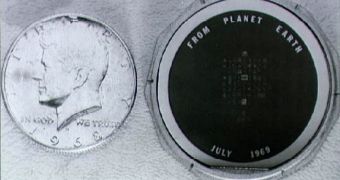In the 1960s, in the middle of the cold war, the United States struggled to keep up with the Soviet Union in a so-called space, that had already surpassed them by being the first nation to successfully put a man in Earth's orbit. As a response, the President of the U.S., John Fitzgerald Kennedy in its famous speech on 12th of September 1962 held on the Rice Stadium, proposed that the U.S. should put a man on the Moon by the end of the decade.
On 16th of July 1969, the Apollo 11 mission was launched from the surface of the Earth, with the help of a Saturn V rocket. Four days later, it made history, by being the first manned spacecraft to land on the lunar surface. Aside from the crew and experiments that it had on board, the Apollo 11 lunar module also carried a small white cloth pouch containing a small case. Within the metal sheath there was a silicon disk the size of a half dollar coin and 73 messages were attached to the disk, written with letters no longer than the width of a human hair.
The small item, hidden among other equipment, was seen as insignificant and easily forgotten. Recently a book, called "We Came In Peace For All Mankind: The Untold Story Of The Apollo 11 Silicon Disk", written by Tahir Rahman, a physicist from Kansas, unravels the story of the small plate that carried mankind's message. Tahir who has a passion for collecting particular letters or documents signed by the first man that walked on the Moon's Surface, or related to the Apollo 11 mission, has recently found a copy of the disc deposited on the surface of the moon and became curious about its history.
The item is barely known in the scientific community and is mentioned only in a few of the documents related to the history regarding the Apollo 11 mission, so Rahman wanted to find the whole truth about the small disk.
As soon as the decision was made to put the American flag on the Moon's surface and after the finalizing of the inscription of the plaque that stated "we came in peace for all mankind", NASA was authorized by the U.S. State Department to request a message of good will from all the leaders of the world, to be taken and left on the Moon, but the request came with only a month before the launch of the Apollo 11, and NASA didn't know if there was enough time or how to archive all the messages before the flight.
Out of the 116 countries contacted by NASA, only 73 responded in time, due to the fact that some of the countries were confused due to the nature of the request and replied by asking details without knowing that there was not enough time for such actions, while others replied by sending information about the method of recording and depositing the message on the surface.
Meanwhile NASA had its own concerns about the method of recording the message, so it turned to the Sprague Electric Company of North Adam, Massachusetts to find a solution, which had previously designed and produced several components for the Apollo 11 spacecraft. But the request stated by NASA was somehow unique and needed innovative techniques. Nevertheless, the company designed in just three weeks a method of inscribing microscopic messages on a 99 percent pure silicon disk, thus completing its obligations stated in the contract, with just a week before liftoff.
Five days before the mission launch, NASA packed the metal case containing the silicon disk and placed it in a small pouch near some of the other commemorative items, carried by astronaut Edwin Eugene Aldrin in a pocket on his sleeve.
On the day on the Moon landing, the astronauts first explored the surface, collected about 50 moon rocks, set up the scientific instruments, after which they took part in the commemorative activities of erecting the U.S. flag and reading the inscriptions written on the lunar module.
The package contained in Aldrin's sleeve was tossed down to the surface, as the astronauts climbed the spacecraft ladder preparing to leave and still lies a few feet from the place were the first boot print was made on the Moon.

 14 DAY TRIAL //
14 DAY TRIAL //